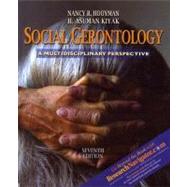This best-selling, multidisciplinary, text on the experience of growing old presents positive images of aging while considering the many factors that contribute to how older individuals experience life.
Up-to-date and expanded, Social Gerontology, Seventh Edition, offers a comprehensive view that presents aging positively, portraying concepts of active aging and resilience, and defining productive aging by elaborating on the many ways elders contribute to society and to their families. Based on the latest research findings, it offers greater depth to critical issues of aging, attending to differences by age and cohort, gender, ethnic minority status, sexual orientation, and socio-economic status.
New features to the seventh edition include:
- FREE subscription to Research Navigator™ with every new book. This subscription offers unlimited access to Research Navigator™ for six months from any computer with an Internet connection.
- Automatically packaged with new copies of this text is the Research Navigator™ Guide for Social Gerontology, a guide that encourages readers to go beyond the book to explore current research and news on aging from articles in leading scholarly journals, popular magazines, and The New York Times.
- Expanded discussion on international and cross-cultural aging issues, emphasize immigrant and refugee elders and multigenerational and intergenerational exchange across the life span that affects quality of life in old age.
- New material on future directions in aging and career opportunities is interspersed throughout the text.








